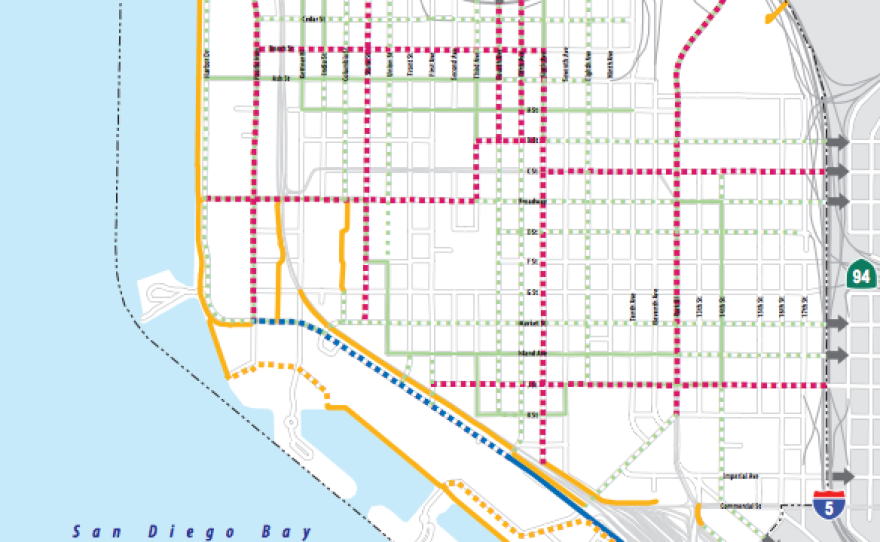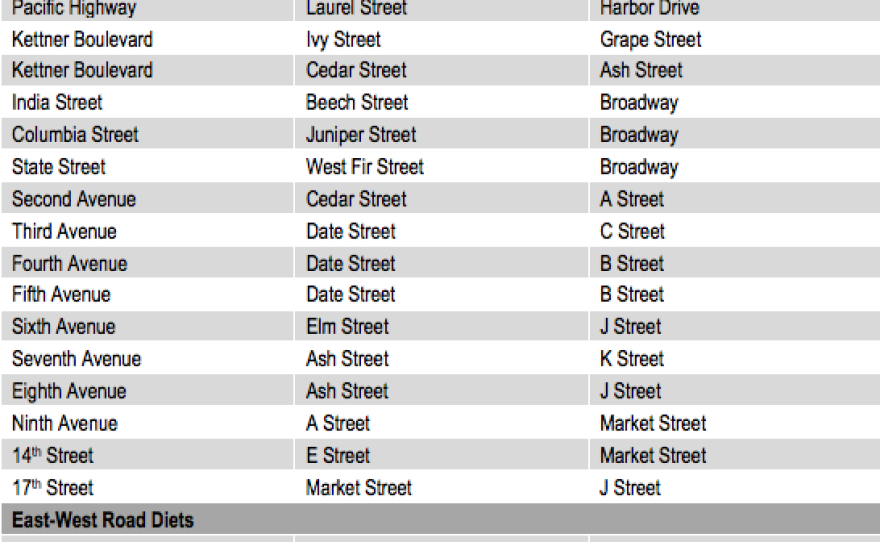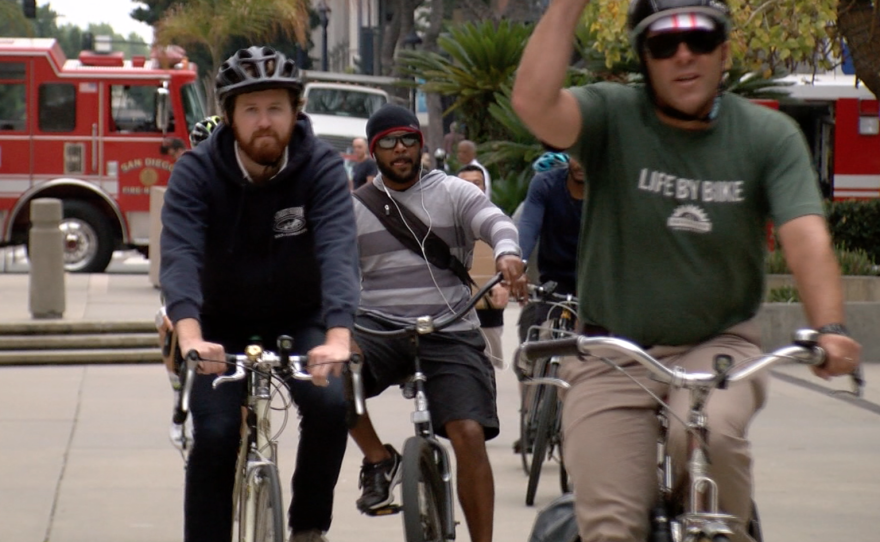Supporters say the city of San Diego just a huge step forward, toward achieving its climate action goals and transforming downtown. The city Council has approved a plan to read 9 miles of new bike lanes and widened 5 miles of sidewalks in the heart of the city. Recently reporter Clare Trageser took a bike ride with Andy Hanshaw to try to see what the new plan might look like. Try to keep up expect he took me on a bike tour of the downtown streets that would get bike lanes. We are now on sixth. Many of the bike lanes would be protected. It has a physical separation between the bike lane and car traffic. On sixth Avenue and car traffic. On 6th Avenue, Hinshaw says he sees too much room for cars. You can see the three lanes on the street, with two lanes of parking, that's too much. There's plenty of roadway for a bike lane. Joining me now in studio is Clare Trageser. This is called the Downtown mobility plan, we heard in the clip it affects the section of sixth Avenue, what other areas are in form mobility makeover? It's a network of streets downtown, it would add protected bike lanes on Pacific Highway and State Street and fourth, fifth, and Fifth Avenue's. Park J and C streets and Broadway in Beech Street. What's it going to look like? It's kind of a grid that goes through downtown and up into little Italy, some streets going east to west and some go north to south. To all of the bike lanes? There's 9 miles of new bike lanes and 5 miles of widened sidewalks. When will the bike lanes go out? I think that's what the city is figuring out, the plan has been passed. The goal is rolling out in the next couple of years. One of the appeals of the plan is that all the lion -- lanes will be added at once. Why is that important? They talk about that it's this network of bike lanes, the important thing is, if you've ever written on a bike lane, you need to go on a bike lane in one direction and then turn on a bike lane in another direction. It doesn't do very much good, if you're on a bike lane that sons the -- that stops. You, took a longer by great downtown -- did you feel safe? We rode most of the network of where the new lanes would go. Maybe my experience wasn't accurate, as you heard, I had a guide and experienced urban cyclist. Even that, I felt like there were some close calls or things that you always have to be looking and make sure someone is it going to open their car door, a bus pulls up, cars might drive too close to. You feel like the one that shouldn't be there. Yes. The one -- you're definitely the most vulnerable, if you get it you will be the one that gets hurt. You are the one that has to be watching out for yourself. You can't necessarily trust that cars will see you are know that you are there. What's going to happen to parking spaces downtown? It's interesting, in the first few years of the plan, the number of parking spaces goes up, the reason is that they are converting a lot of parallel parking spaces into diagonal, which fits in more cars. Doing that overall, adds 600 parking spaces, as the plan is implemented. Then they are reducing parking in some places, some for the bike lanes and more for the actual expanded sidewalks. Overall, as the plan is completely rolled out in 30 years, there will be about 475 fewer parking spaces then there are right now, even though the number will initially go up, then it will go back down. If that makes sense. It does. As they are doing it we will see more parking spaces, as this goes through to its conclusion, there will be fewer. What kind of a world does this plan play in San Diego's hopes of reaching its climate action goals? That's one of the big points that proponents have made. Downtown is just one portion of San Diego, obviously. The overall goals are for the whole city of San Diego, but Civic San Diego, the agency that design this plan, says it will increase biking and walking in downtown from 20 -- 28%, to 43% by 2035. That exceeds the climate action plan goals in the downtown area. As opposed to this plan? Business groups like the regional Chamber of Commerce are in support, there are specific people, especially in Little Italy, residents and business owners who live on ash street or State Street -- sorry beach street or State Street who own businesses there that are opposed because it reduces parking on those streets by about 40 spaces. It's kind of a microcosm, overall it increases parking in Little Italy, but it reduces it on those streets, people are posed and their concerns about the church and the school. It might impact drop-offs or limousines pulling up to the church for weddings. The plan has made concessions to those by moving the bike lane, one Lane over, so there will be room for people to pull up at the church, for example. I've been speaking with Clare Trageser.
The San Diego City Council on Tuesday unanimously approved a plan for downtown San Diego that will add nine miles of new bike lanes and more than five miles of widened sidewalks. In 10 years, it will also begin eliminating parking spaces.
Called the Downtown Mobility Plan, it will add protected bike lanes on Pacific Highway and State Street; Fourth, Fifth and Sixth avenues; Park, J and C streets; and Broadway and Beech Street. It will also extend the bike lane on Harbor Drive and the bike path along the bay.


The plan would set up so-called "road diets" — meaning reducing a car lane or parking — on several downtown streets, including portions of Kettner Boulevard, India Street and Second through Ninth avenues.
Brad Richter, an assistant vice president of planning at Civic San Diego, which designed the plan, said that it will increase the number of people who walk and bike downtown from 28 percent to 43 percent by 2035.
Richter said by the time the plan is fully implemented in 30 years, downtown will also have 477 fewer spaces than it does now.
Some residents and business owners opposed the plan. In particular, those in Little Italy asked the plan be changed to put bike lanes on Ash Street instead of Beech Street and on Kettner Boulevard or Pacific Highway instead of on State Street.
Richter said Ash and State streets were chosen because they have less traffic and slower speed limits, which makes them safer for cyclists. He said the other options were considered but wouldn't work.
The Cleveland National Forest Foundation, an environmental nonprofit, also opposed the plan because it does not add public transit, said Jana Clark, the group's secretary.
"We cannot let this opportunity pass without addressing transit," she said. "The bike and walk is a great start, but we need the critical missing component."
The plan will help downtown exceed the transportation goals laid out in the city's Climate Action Plan, Richter said. The climate plan calls for increasing the number of people who commute by bike from 1 percent to 18 percent by 2035 for people who live within a half mile of existing or planned transit stops, which includes downtown.
Kris Michell, CEO of the Downtown San Diego Partnership, said she supports the plan over the first 10 years but hopes the City Council will revisit it in a decade to be sure lost parking is mitigated.
Before the City Council vote, Andy Hanshaw, head of the nonprofit San Diego County Bicycle Coalition, led a rally of cyclists who traced the new bike lanes' route.
Evan Burbridge joined in the ride. He lives in North Park and said he bikes to work in downtown every day.
"Cars aren’t necessarily aware you’re going to be riding right next to them in the lane, especially when cars are stopping, turning, waiting for pedestrians to cross. They’re really not aware of you as a cyclist," he said.
The $63 million plan will now go to city staffers, who will design how it will be implemented.






